
Dubai: Recently, in an attempt to establish excellence and consistency in laboratory tests being conducted for COVID-19, the World Health Organisation (WHO) conducted a global external quality assessment programme. The only laboratory from the Middle East which participated in this assessment was the UAE’s indigenous and largest COVID-19 testing laboratory group, Pure Health.
Pure Health has been responsible for conducting over 5.5 million Reverse Transcriptase Polymerase Chain Reaction (rt-PCR) tests since the beginning of the pandemic in the UAE, which accounts for conducting over 70 per cent of the tests totally in the UAE for COVID-19 detection so far. Working in close tandem with the Ministry of Health and Prevention and other health authorities in the UAE, Pure Health has been conducting over 80,0000 rt-PCR tests and 11,000 antibody tests daily which accounts for over 70 per cent of the COVID-19 tests conducted in the UAE.
Dr Gurdip Singh Dhatt, Chief Medical Officer for Pure Health in conversation with Gulf News, discussed the best practices at their group of laboratories and what it took them to eliminate error margins and work to near perfection in record time.
Gulf News: The WHO has certified the quality of your testing methods. Could you explain what makes one lab methods more superior to another when the methodology of testing, the process, the assay etc is the same everywhere?
Dr Gurdip Singh Dhatt: There are many factors which differentiate between laboratories. The physical structure and layout, safety practices and the implementation of a robust Total Quality Management systems are important prerequisites for any clinical laboratory. Even though the basic principle of testing may be the same or similar across laboratories there are significant difference in the performance levels of different analysers [machines], reagents and equipment used in individual laboratories. A key factor, often overlooked, that distinguishes the good from average laboratories is the presence of well qualified and experienced professionals in the relevant speciality.
Some labs give out results in 24 hours, some in 48 and others in 72. Why is there a difference in the turnaround time for the test?
The reporting turnaround time of a laboratory is determined by the capacity of the laboratory to handle a given number of samples within a specified time frame. This is dependent on the physical size of the laboratory, the capacity of the equipment to handle the number of samples within a specified time and the presence of adequate numbers of appropriately trained and experienced personnel. Samples may also be prioritised based on clinical necessity i.e. individuals with symptoms/complaints will have the samples prioritised over those being tested as part of a screening process.
We have heard of false positives and false negatives. Can you throw some light on this and how this can be avoided?
Every test can produce false positive and false negative results. There are scientific publications about the performance of different test methods and a laboratory should aim to avoid using those tests with poor/inferior performance. In the context of COVID-19, a poorly collected sample is the most common cause of false negatives. Reporting errors can be avoided by following strict quality control measures and review of results, before reporting, by appropriate professionals.
Your lab has the distinction of conducting over 5 million tests ever since testing began in the UAE. Please share the importance of this figure and also what it means when we say that the UAE has conducted test in over 60 per cent of the population. Explain the correlation between more testing and infection control.

In the early stages of this pandemic, professional bodies recommended only testing those individuals who had symptoms of the disease. However, it is well known now that between 60-80 per cent of individuals who test positive for COVID-19 have no symptoms. Therefore these individuals can spread the virus to others; some of whom may develop serious illness. Screening large numbers of individuals without symptoms will identify those who require to be quarantined and also allows contact tracing of individuals who may have been exposed. These measures help in containing the spread of the virus.
How does the company maintain consistency in quality control?
We have established and maintained a robust Total Quality Management system. Pure Health maintains a consistent level of quality laboratory services. This includes facilities that meet the regulatory requirements, employing well qualified and trained individuals for specific roles, implementing good laboratory practices with frequent monitoring through internal audits, participating in international accredited external quality assurance programs and having the laboratories accredited to reputed international accreditation standards.
What are the future plans of Pure Health?
We plan to continue being a centre of excellence when it comes to clinical diagnostics and maintaining our status as the largest network of clinical Laboratories in the region. With a focus on best clinical practices and quality management.









